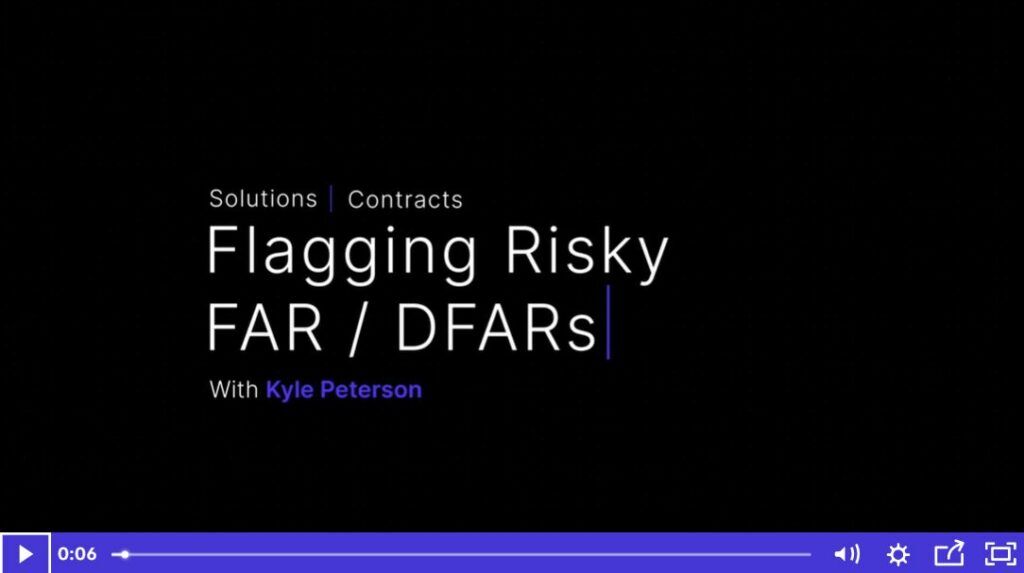FAR clauses are familiar territory for Proposal Managers working with US Federal Programs, who typically spend hours reviewing solicitations for FAR / DFAR clauses. So what are they, and why are they so important?
FAR clauses are Federal Acquisition Regulations, and DFAR clauses are Defense Federal Acquisition Regulations. If you fail to comply with a regulation, it can have serious implications. Not only for the bid itself but also for your budget and even for your reputation. To keep things simple in this post, we’ll refer to FAR clauses. But the same applies to DFAR as well as other industry specific clauses.
What happens if you fail to assign a FAR clause?
The process relies on an organization’s Proposal Manager, Contracts Manager or Legal Team catching all FAR clauses within a solicitation. They then assign these responsibilities to the correct team as part of a Responsibility Matrix. This is usually done manually. It can take hours, or even days if the solicitation is hundreds of pages long. So what happens if you miss a FAR clause?
Let’s Take an Example
This example is from a company providing communications equipment. The Proposal Manager misses a training clause in the proposal. They fail to assign it to the Human Resource (HR) Manager. That means the HR Manager hasn’t checked that the training is feasible. Nor have they assigned a budget to it. They need to quickly find an approved subcontractor and add this element of the work to the budget. This costs the firm both time and money and risks damaging the professional relationship between the Proposal Manager and HR Manager. If the HR manager is unable to find an approved subcontractor the company could be fined by the government. It also opens up the possibility of protests from other bidders and they could lose the contract.
Another example is a company that builds army tanks. Everything from the body to the road wheels and fume extractor. The latest solicitation includes a new FAR clause that dictates how you must build your fume extractor. Your company would need to source extra materials to meet the new requirements. However, you created your Responsibility Matrix manually and missed the extra FAR clause. You failed to assign it to the correct team, so they didn’t do due diligence. If they had, they would have reported back that the new materials are expensive. You should have allocated extra budget to the bid. Now, you’re stuck with absorbing the extra costs yourself. Bad news for your internal reputation, and bad news for your firm’s bottom line.
How to minimize the risk of missing FAR clauses
These risks can be mitigated by using solutions that automate the process. Here’s how you assign FAR clauses, or any other clauses, using VT Docs’ Responsibility Matrix.

Step 1
Create your FAR dictionary. You have two options here. You can either:
- Download a dictionary from VisibleThread’s Dictionary Marketplace and customize it to your needs.
Or
- Create your own from scratch. You will need to assign your categories (teams). So FAR 52.123 goes to Sales, FAR 52.456 goes to Pricing, etc.
Step 2
- Upload your solicitation to VT Docs.
- Shred the solicitation against your FAR dictionary.
- The solution scans for relevant FAR clauses.
- VT Docs automatically generates a Responsibility Matrix shredded into MS Excel. It highlights instances of relevant clauses broken down by team. You can then share the Excel sheet with your teams, who can filter the clauses that apply to them.
Watch this video about how to create a Responsibility Matrix
The hidden benefits of automatically assigning FAR clauses
By automating this part of the process, you’re obviously saving yourself time. The process of assigning FAR clauses for your Responsibility Matrix takes seconds, as opposed to hours or days.
But this isn’t your only benefit. We’ve written before about how automating this process ensures greater accuracy as well as speed. This means you won’t lose money paying to fulfill requirements that weren’t originally accounted for. You’ll protect your reputation amongst colleagues, and minimize the risk of having your contract taken away.






